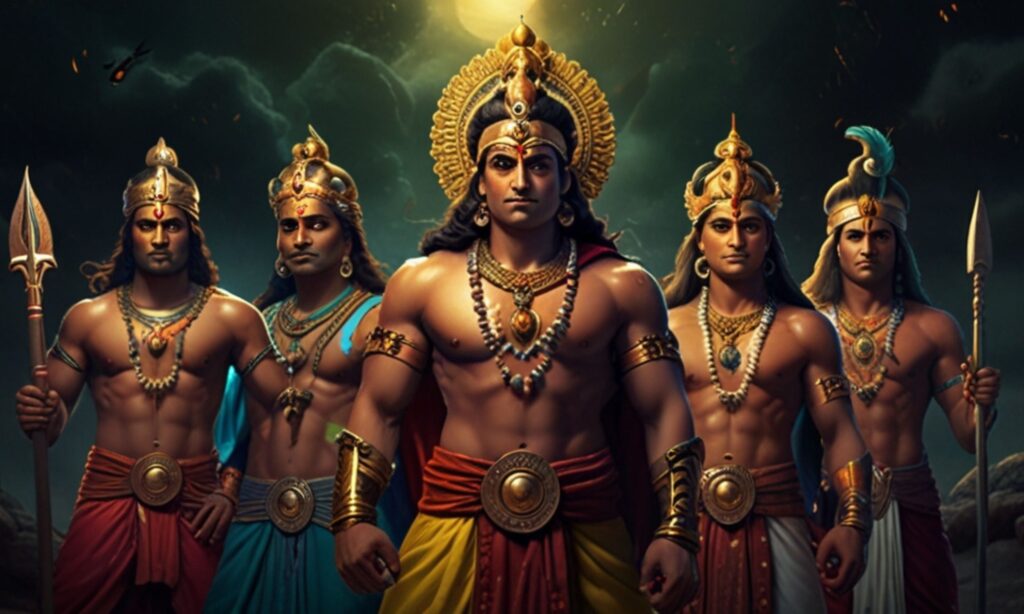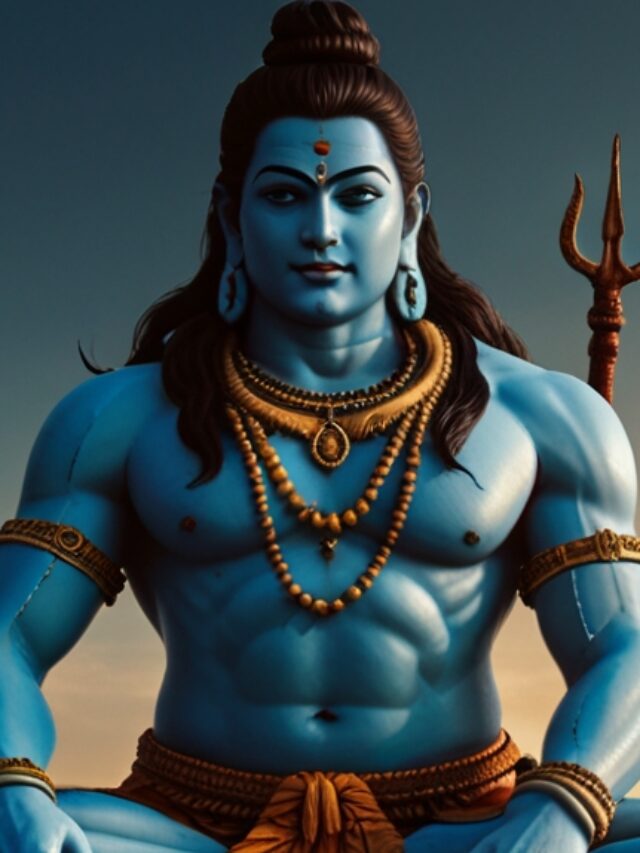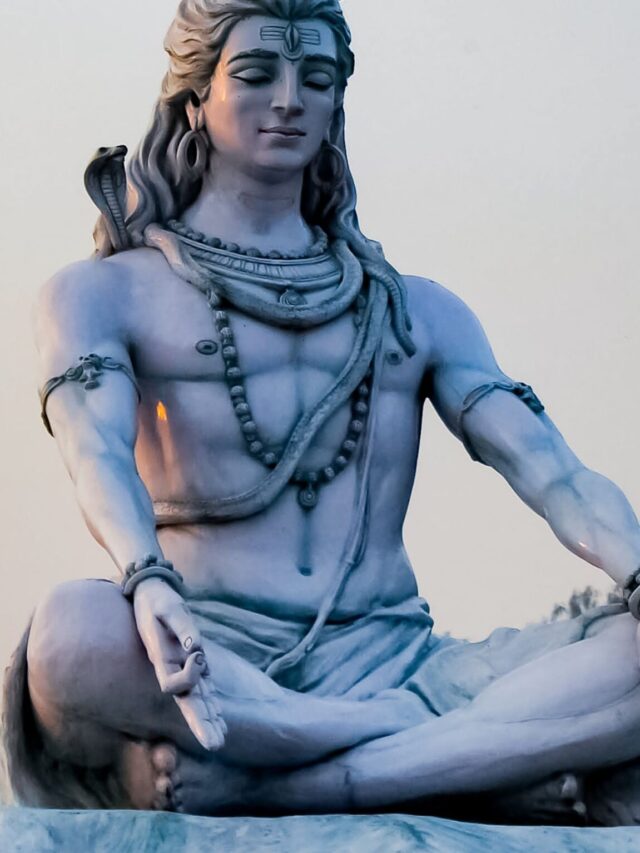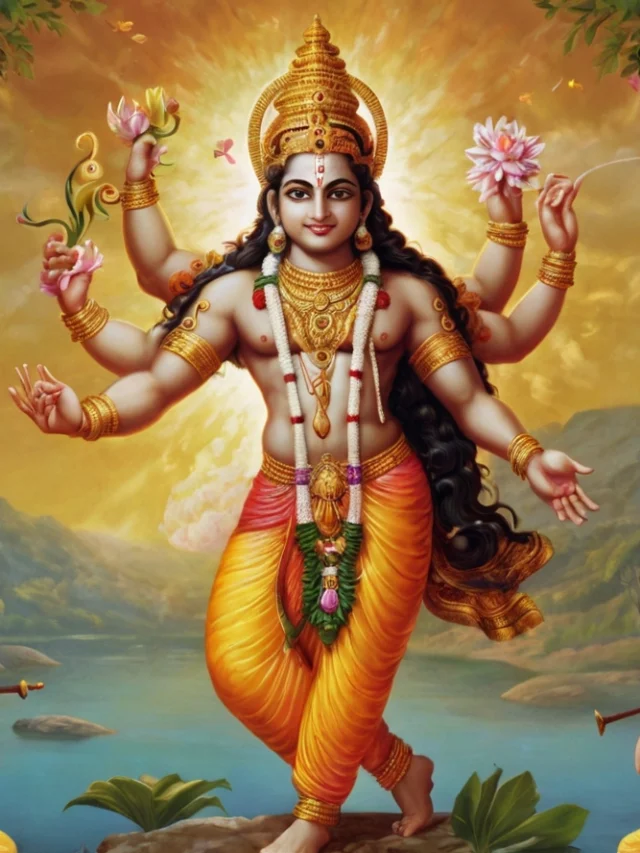Explore the Queens of Kuru: Amba, Ambika : Queens of Kuru, Their Legacy, Their Sacrifice, The Price of Power in Mahabharata. Discover the sacrifices made and the price paid for wielding power.
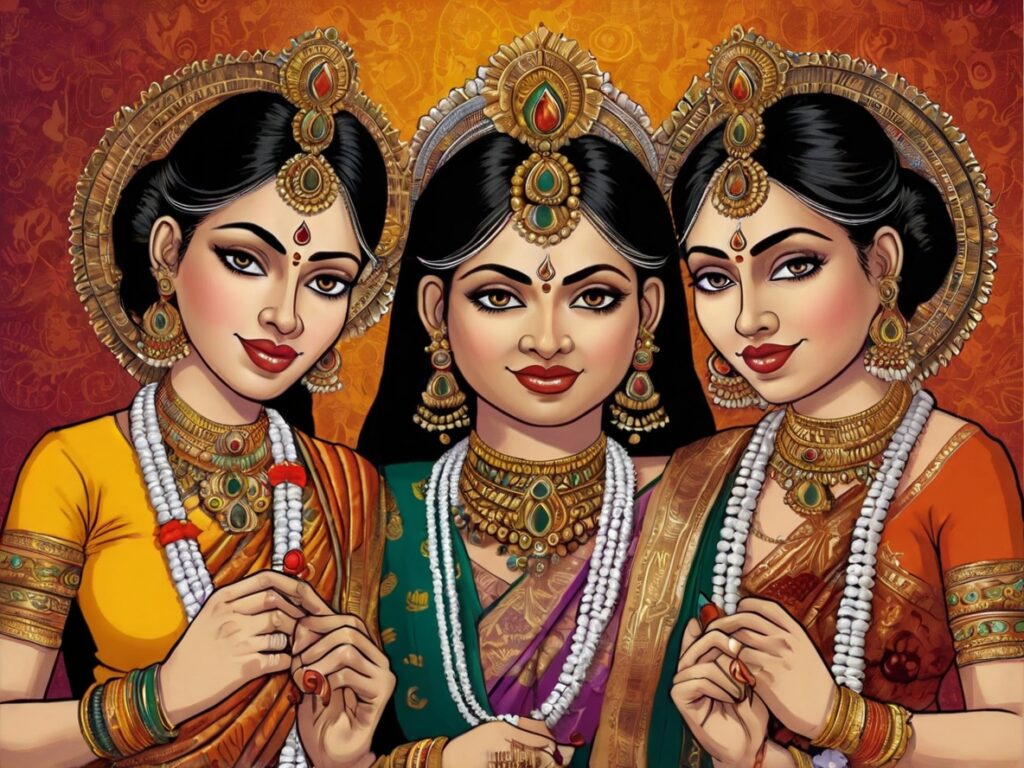
The story of Amba, Ambika, and Ambalika in the Mahabharata is intertwined with Bhishma’s vow of celibacy and the events leading up to the Kurukshetra war. Here’s a breakdown of their roles:
The Swayamvara and Bhishma’s Intervention:
Amba, Ambika, and Ambalika were the beautiful daughters of King Kashya of Kashi. During their Swayamvara, a ceremony where they would choose their husbands, Bhishma arrived to select brides on behalf of his half-brother, the young King Vichitravirya.
Bhishma, known for his immense strength, challenged and defeated all the assembled suitors, winning the right for Vichitravirya to choose any of the princesses.
Amba’s Broken Promise:
Unlike her sisters, Amba approached Bhishma after the ceremony. She revealed she was already in love with another king, Shalva, and wished to marry him.
Bound by his vow of celibacy, Bhishma couldn’t marry her himself. He respected her wishes and escorted her to King Shalva’s court.
 Rejection and a Burning Desire for Revenge of Amba
Rejection and a Burning Desire for Revenge of Amba
Rejection and a Burning Desire for Revenge:
Unfortunately for Amba, King Shalv refused to accept her as his bride. He felt she was already “won” by Bhishma in the Swayamvara. This public rejection humiliated and devastated Amba.
Consumed by a desire for revenge against both Bhishma and King Shalv, Amba sought help from various warriors and sages. However, none dared to challenge the mighty Bhishma.
- Finally, Amba met Parasurama, Bhishma’s revered teacher. She convinced him of her plight and the injustice she faced. Parasurama, enraged by Bhishma’s inaction, challenged him to a duel.
A Clash of Duty and Loyalty:
The battle between Bhishma and Parasurama lasted for 23 days, with neither gaining a clear advantage. Even their celestial weapons proved ineffective against each other. The earth itself trembled under the force of their clash.
Ganga, the celestial river goddess and Bhishma’s mother, intervened in the battle. She pleaded with Parasurama to understand Bhishma’s difficult position. He was bound by his vow of celibacy and couldn’t disobey his father’s command.
A Determined Sacrifice:
- Realizing the truth behind Bhishma’s actions, Parasurama ended the duel. Amba, however, remained undeterred. She chose self-immolation as a means to end her suffering and become a spirit dedicated to Bhishma’s destruction.
Rebirth and Fulfillment:
- In her next life, Amba was reborn as Shikhandini, a woman with a man’s form granted by a boon. This unique form allowed Shikhandini to eventually slay Bhishma during the Kurukshetra war, fulfilling Amba’s vengeful vow.
Ambika and Ambalika’s Fate:
Ambika and Ambalika, unlike Amba, didn’t express any objection to marrying Vichitravirya. They became his queens, but sadly, Vichitravirya died young and childless.
To ensure the lineage continued, Satyavati, Vichitravirya’s mother, invoked the ancient custom of Niyoga. Through Niyoga, her firstborn son, Vyasa, fathered children with both Ambika and Ambalika.
Ambika gave birth to the blind Dhritarashtra, who became the father of the Kauravas. Ambalika gave birth to the wise Pandu, who became the father of the Pandavas.
The Enduring Impact:
- Though Amba’s story focuses on her tragic rejection and vow for revenge, Ambika and Ambalika’s roles are significant. Their marriages to Vichitravirya and the subsequent births of the Pandavas and Kauravas set the stage for the epic conflict that unfolds in the Mahabharata.
Themes Explored:
- The story of these three princesses highlights several themes:
- The limitations placed on women in choosing their husbands.
- The importance of keeping promises or facing the consequences.
- The role of fate and duty in shaping lives.
Beyond the Surface:
- Some interpretations delve deeper, suggesting Amba’s rejection symbolized the decline of Kshatriya (warrior) dharma and Bhishma’s vow representing the weakening of the Kuru dynasty.
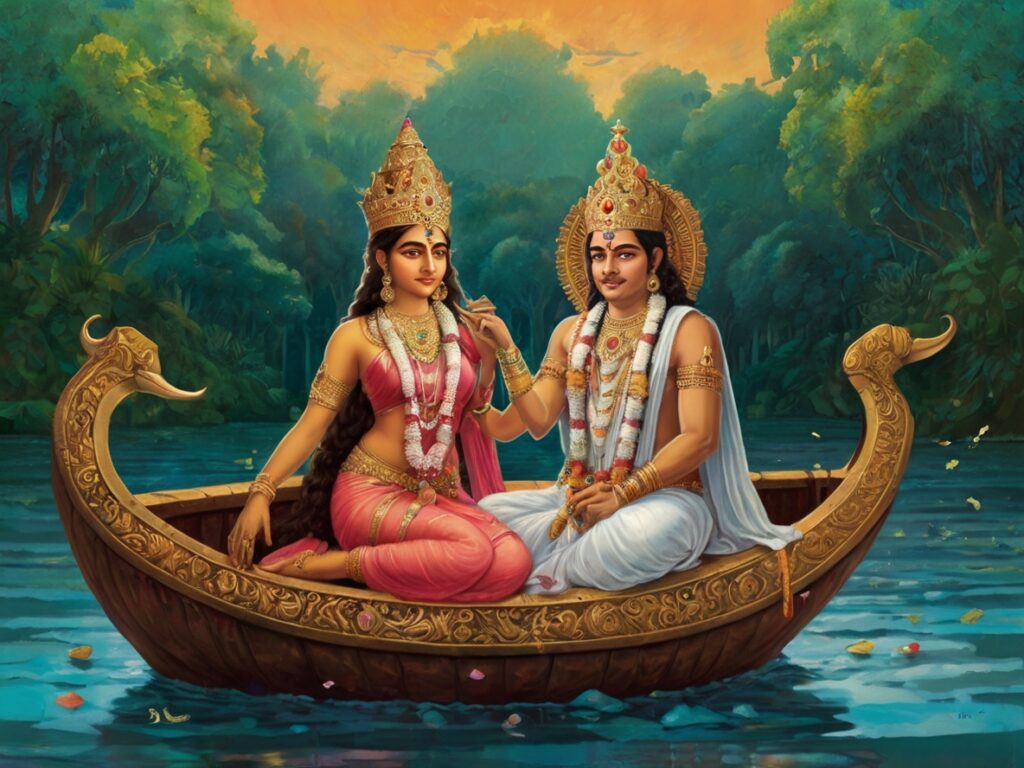
The story of Parashara and Satyavati
In the Mahabharata, the story of Parashara and Satyavati is a tale of chance encounters, divine blessings, and the birth of a pivotal figure. Here’s a breakdown of their story:
The Chance Meeting:
Satyavati, the beautiful daughter of a fisherman, earned her living ferrying passengers across the Yamuna River. One day, she was tasked with ferrying the sage Parashara, known for his wisdom and immense power.
Overcome by Parashara’s strong presence, Satyavati felt a sudden surge of desire. However, she was concerned about the scandal it would create.
The Deal and the Boon:
Parashara, understanding her predicament, offered a solution. He proposed a temporary union that wouldn’t tarnish her reputation. He promised that she would regain her virginity and her body would exude a pleasant fragrance (some versions say the scent of musk) as a blessing.
Satyavati, after some hesitation, agreed due to her respect for the sage and the promise of a divine blessing. They had a brief union on a boat magically created by Parashara to shield them from view.
The Birth of Vyasa:
From their union, Satyavati conceived a son who would be known as Vyasa. He was born with dark skin and a fiery temperament, reflecting the nature of his father, Parashara.
After his birth, Parashara blessed Satyavati and immediately left, returning to his life of meditation.
The Legacy:
Vyasa would later become a pivotal figure in the Mahabharata. He authored the epic itself and played a crucial role in the birth of the Pandavas, the central heroes of the story.
Satyavati’s encounter with Parashara, while unconventional, led to the birth of a figure who shaped the course of history in the epic. Her story highlights the role of fate and divine intervention in the narrative.
The Birth of the Pandavas and Kauravas: A Tale of Duty, Loss, and Divine Intervention
The birth of the Pandavas and Kauravas, the central figures in the Mahabharata, is a story steeped in duty, loss, and the intervention of divine powers. Here’s how it unfolded:
A King’s Dilemma:
King Shantanu, the founder of the Kuru dynasty, desired to marry Satyavati, a beautiful fisherwoman. However, her father had a condition – her sons would inherit the throne, not Shantanu’s existing heir, Bhishma.
Bhishma, ever devoted to his father, took a vow of celibacy to pave the way for Shantanu’s marriage and ensure the continuation of the lineage.
Satyavati’s Desperate Move:
King Shantanu and Satyavati had two sons, Chitrangada and Vichitravirya. However, both died young and childless, leaving the Kuru dynasty on the brink of extinction.
Determined to secure an heir, Satyavati, with Bhishma’s consent, invoked the ancient custom of Niyoga. Niyoga allowed a woman whose husband was deceased or incapable of having children to have a child with another man, usually a close relative.
Divine Intervention:
Satyavati’s firstborn son, Vyasa, born from her union with a sage named Parasara, was chosen to perform Niyoga. Vyasa, known for his wisdom and austerities, possessed immense divine power.
Satyavati first sent Ambika, the elder wife of Vichitravirya, to Vyasa. Overwhelmed by his appearance, Ambika closed her eyes during the ritual, resulting in the birth of Dhritarashtra, who was born blind.
Ambalika, the younger wife, fearing Vyasa’s appearance, sent her maidservant in her place during the Niyoga ritual. The maidservant, terrified by Vyasa, gave birth to Pandu, who was pale and sickly.
Finally, Satyavati herself went to Vyasa, this time prepared. Their union resulted in the birth of Vidura, a wise and virtuous counselor, though not destined for the throne.
Seeds of Conflict Sown:
This unconventional method of birth led to the creation of two branches within the Kuru clan – the Kauravas, descendants of Dhritarashtra, and the Pandavas, sons of Pandu.
Dhritarashtra, though the elder brother, was unfit to rule due to his blindness. Pandu, despite his physical limitations, was seen as a rightful heir due to his righteousness. This power struggle between the cousins, fueled by ambition and differing ideals, would ultimately culminate in the devastating Kurukshetra war.
The Legacy:
The birth of the Pandavas and Kauravas serves as a turning point in the history of the Kuru dynasty. It highlights the complexities of duty, family loyalty, and the consequences of difficult choices.
This dramatic tale emphasizes the role of fate and divine intervention in shaping the course of events. The birth of these cousins sets the stage for the epic conflict that would forever define the Kuru dynasty’s legacy.
